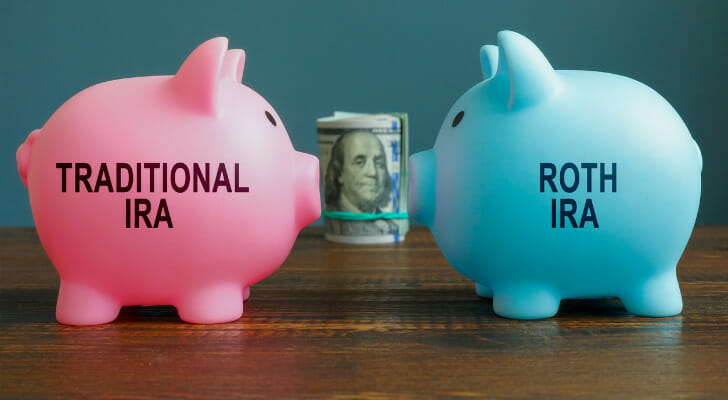Saving for retirement is an important part of financial planning for nearly all Americans. There is currently a gap of $28 trillion between what Americans have saved for retirement and what they actually need, and that’s expected to grow to $137 trillion by 2050, according to the World Economic Forum. One of the best ways to save for retirement is to create a retirement fund. This is a general way of saying saving for retirement using multiple types of specially designed financial accounts from a bank or other financial services company. There are a few types of retirement accounts you can choose from, and each has their own steps for starting one. For more help with planning for retirement, consider working with a financial advisor.
Defining a “Retirement Fund”
A retirement fund can mean a few different things. At its core, it could be simply money you set aside for your retirement. These funds could be stored in a checking account, savings account or even technically a piggy bank. None of these are the best options, though, as your money is staying stagnant and not working for you enough in each scenario. In fact, in most cases it’s becoming less valuable as inflation increases, changing the value of money over time.
When most people talk about a retirement fund, what they really mean is a collection of retirement accounts. A retirement account is a specific financial instrument where you can put money for your retirement and invest it in various places so that it grows and multiplies. Different retirement accounts have special features that are meant to help you save for retirement. This most notably includes tax benefits that allow you to maximize your savings and retirement income potentials.
Workplace Retirement Accounts and How to Open One
The first broad category of retirement accounts are ones that you open through your employer, generally known as workplace retirement accounts. These accounts are only offered through employers, so the first step for any of them is to talk to someone in your HR department and see what if anything is offered at your company. If there isn’t a plan available at your employer, then the accounts below may not be attainable as long as you’re at your company.
401(k) Plans
401(k)s are by far the most common type of workplace retirement plan. It works like this: you designate a percentage of each paycheck to be put into your account. The money is taken out of your paychecks before taxes are paid, meaning it’s allowed to grow tax-free. You then designate your investments, with options decided by the bank or financial institution your employer uses.
You may also get an employer match to help you maximize your deposits. This is when a certain amount of money you contribute to your 401(k) is matched by your employer, up to a preset limit. This is essentially free money, so make sure you take advantage of it if it’s offered.
Later, in retirement, you take money out of the account in distributions. Taxes are paid on the money when it is withdrawn since it wasn’t taxed in the first place.
To open a 401(k) account, you’ll have to go through your employer’s HR team or online portal. This will generally be done either when you join the company or during a yearly enrollment period.
403(b) Plans
A 403(b) plan functions essentially the same way as a 401(k), but it is generally for non-profit corporations and public sector organizations like schools and municipal government. They include the same tax benefits as a 401(k) as well.
Again, you’ll sign up for a 403(b) account through your employer, either when you start working or during an annual enrollment period.
457(b) Plans
A 457(b) plan is a retirement account used mostly by government employees. It also works very similarly to a 401(k) plan, in that you put a portion of your salary into the account pre-taxes and withdraw it later in life, paying taxes on distributions. Again, you’ll sign up for this type of plan through your employer.
Individual Retirement Accounts and How to Open One

These plans are options for workers who don’t have access to a workplace retirement plan or who, more importantly, want to diversify their retirement savings between multiple account types. There are a few options, each with its own benefits and limitations.
Traditional IRA
A traditional IRA was, for a long time, the standard for individual retirement accounts. It works similarly to a 401(k), but you open it yourself rather than through an employer. Money is not taken directly from your paycheck, but you will designate how much you wanted to be deposited from your bank account and how often.
Money in an IRA is also deposited tax free. In turn, you’ll declare any money you’ve deposited when filing your taxes, and it will be deducted from your total taxable income. Again, you’ll pay taxes later in life when you take withdrawals.
To start a traditional IRA, pick a financial institution and go to their website. Find the section on IRAs and follow the instructions for opening an account. You’ll generally need to link the IRA up a bank account for deposit purposes. A good start might be to check with the same institution you do banking with and see if they offer IRAs. A financial advisor can also help you here.
Roth IRA
A Roth IRA is similar to a traditional IRA, but the money is put in after you pay taxes on it. So in the short term, it won’t be deductible from your taxable income, which means you’ll pay more taxes while you work. The massive tradeoff, though, is that your withdrawals in retirement are not taxed. That means your Roth IRA income in retirement will be entirely tax-free.
The process for opening a Roth IRA is the same as a traditional IRA. Choose a financial institution, open an account probably online and link a bank account.
Self-Employed Retirement Plans
Most people will be able to use one of the above plans. However, there are special retirement plans for self-employed people as well. The most popular of these are SIMPLE IRAs and SEP-IRAs.
Both of these accounts are for very small businesses or sole proprietors. If you have a few employees, you can also open these for them. Both are opened by working with a financial institution that offers these types of accounts. In turn, you can open one by getting in contact with a representative at a company you trust.
These are a bit trickier than the other types of retirement accounts described here, so working with a business financial advisor or an accountant may be helpful.
Bottom Line
There are a number of retirement accounts you can open to use as part of your retirement fund. Some of them are offered through employers, while others you can open yourself. All of them can help you plan for your retirement so that later in life you can spend your golden years enjoying your family and friends.
However, remember that a true “retirement fund” will typically include multiple types of accounts. That means having a 401(k) at your company, your own IRA and maybe a high-yield savings account. By diversifying your assets in multiple places, you’ll maximize your financial flexibility when you retire.
Retirement Planning Tips

- For help with any retirement questions, consider working with a financial advisor. Finding a qualified financial advisor doesn’t have to be hard. SmartAsset’s free tool matches you with up to three financial advisors in your area, and you can interview your advisor matches at no cost to decide which one is right for you. If you’re ready to find an advisor who can help you achieve your financial goals, get started now.
- One key retirement question is knowing exactly how much money you’ll need for your goals. Use SmartAsset’s free retirement calculator to get a sense of what you’ll need and whether or not you’re on pace.
Photo credit: ©iStock.com/shapecharge, ©iStock.com/designer491, ©iStock.com/shapecharge
